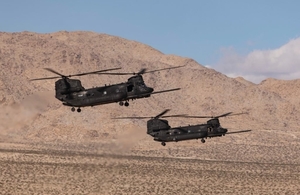British Army deploys alongside US and Australian partners for future warfare experiment
United Kingdom, United States and Australia showcase pioneering equipment during Project Convergence exercise in California

-
Multi-national experimentation promotes rapid data sharing and decision making.
-
Members of the UK Ranger Regiment deployed alongside the US 75th Ranger Regiment for the first time.
Allies from the UK, US and Australia demonstrated the integration of cutting-edge technology alongside key industry leaders, in a series of experimental firsts.
The event, Project Convergence 2022, examines how using artificial intelligence (AI), robotics and autonomy can improve battlefield situational awareness, connecting sensors with shooters and accelerating decision-making speeds.
At Fort Irwin in California the UK deployed 450 troops and 17 technologies were showcased and experimented with, including long-range fires, uncrewed aerial systems, autonomous fighting vehicles and next-generation sensors.
The Rangers worked with the Special Operations Forces and the US 75th Ranger Regiment to explore the deployment and use of the British Army’s new Special Operations Brigade and Ranger Regiment.
Delivering the UK element of the project, 450 soldiers from the British Army, under the UK’s 20th Armoured Combat Brigade Team (20 ABCT), were supported by more than 20 scientists and engineers from the Defence Science and Technology Laboratory.
Experimentation, science and research enables better data capture and analysis to identify successes and address challenges for future war fighting. Supported by Industry partners, PC22 was a whole force demonstration of the direction of the British Army’s modernisation.
Attending the project, Defence Procurement Minister Alex Chalk said:
Delivering on our ambitions outlined in Future Soldier and the Integrated Review, Project Convergence highlights the progress the British Army is making to being more lethal, agile and expeditionary force, through key collaboration with our longstanding international allies and partners.
The project also saw a number of other firsts for the UK:
- A UK Air Surveillance Radar (Giraffe) has connected to a US network to control and manage targets (normally a US only system) for battlefield data sharing.
- ZODIAC, a UK artificial intelligence enabled decision support system that can help Commanders make decisions, was connected to US ‘sensors’, feeding information into a multinational intelligence network.
- A US F35 fighter jet has cued fires for a UK GMLRS missile platform, without the requirement for a person in the loop, cutting the strike time down from minutes to seconds.
- The UK have manufactured US parts using 3D printing, helping them resupply at reach and sharing technical designs of vehicle and weapon parts.
- UK HoloLens (augmented reality lenses) have been used to help logisticians and maintainers fix equipment supported by a technical expert on the other wide of the world.
- Supported by 1 Signal Regiment, a complex multi-national network was established that allowed 20th Armoured Brigade Combat Team to share information with our international partners at speed.
- In a significant collaboration between the new Experimentation and Trials Group, TommyWorks, DE&S and our industry partners, the British Army’s first Robotics Autonomous enabled Close Combat platoon from 2 YORKS was digitally integrated with our allies for the first time.
Through the tri-national collaboration, Project Convergence has placed a renewed emphasis on how data can be transformed into information which can be exploited across weapons systems for the UK, our allies and partners. Support provided by the Defence Science and Technology Laboratory (Dstl) ensured a wealth of data and analysis was captured will be used to identify the best way to employ these technologies in the future.